Matthew S. Williams's Blog, page 15
March 11, 2022
Episode 5: The Search for Signatures
In the search for life and intelligence beyond Earth, astronomers look for telltale “signatures.” These include the chemical elements that we associate with life as we know it and its biological functions (“biosignatures), and indications of technological activity (“technosignatures”) as we would recognize it. At present, the search for signatures is limited by two factors: the limits of our instrumentation, and the limits of our frame of reference.
February 20, 2022
Episode 4: The Planetarium Hypothesis
Is it possible that humanity hasn’t heard from advanced extraterrestrials because they have us trapped in some grand simulation? Or perhaps they have enclosed our region of space and are simulating an empty Universe. This is known as the Planetarium Hypothesis, originally proposed by scientist and science fiction author Stephen Baxter in 2001. While this possibility is likely unprovable, it has an internal logic that is hard to ignore. If you were a super-advanced extraterrestrial intelligence, isn’t this what you’d do?
February 15, 2022
Episode 3: The Transcension Hypothesis
Is it possible that we haven’t heard from any advanced alien civilizations because they’ve “transcended” – i.e., achieved a state of existence so advanced that we can no longer perceive them? This is the essence of the Transcenion Hypothesis, first proposed by John Smart in a 2002 paper, titled “Answering the Fermi Paradox: Exploring the Mechanisms of Universal Transcension.”
February 8, 2022
Podcast Episode 2: The Kardashev Scale!
In this episode, I discuss one of the most well-known concepts in the Search For Extraterrestrial Intelligence – the Kardashev Scale. Named for famed Soviet-Russian astrophysicist Nikolai Kardashev, who died in 2019, this three-level classification system was introduced in his seminal study, “Transmission of Information by Extraterrestrial Civilizations,” published in 1964. The Scale characterizes extraterrestrial civilizations based on the amount of energy they can harness, ranging from the energy of an entire planet to a star system or a galaxy.
In the almost sixty years since it was first proposed, many additions, variations, and articulations have been added to the Scale. Combined with related ideas, like Dyson Structures (or “Megastructures), the Scale has had significant implications for the Search for Extra-Terrestrial Intelligence (SETI) and is considered foundational to the field of study.
Enjoy!
February 6, 2022
My First Podcast: The Great Filter!
At last, I’ve taken the plunge and decided to continue my vlog series as a podcast series! Picking up from where I left off, Episode 1 addresses one of the most famous proposed resolutions to the Fermi Paradox – The Great Filter Hypothesis! First proposed in 1996 by Robert Hanson (Future of Humanity Institute, Oxford University), the theory is best described as follows:
“The Great Filter can be thought of as a probability barrier. It consists of [one or] more highly improbable evolutionary transitions or steps whose occurrence is required in order for an Earth-like planet to produce an intelligent civilization of a type that would be visible to us with our current observation technology.”
The possibility that all advanced life faces this filter has significant implications for human life today, none of which are particularly pleasant! Depending on where the filter resides along the evolutionary pathway, we may either be past it (indicating that we are a fluke), or we could be headed straight for it (indicating that we are on borrowed time).
All this and more in Episode 1!
January 24, 2022
I Finally Get Relativity – Part the Last!
Alright! Welcome back to my short series on finally getting Relativity! In the first installment, I addressed the background to Einstein’s revolutionary breakthrough, which covered Galileo, Newton, and the birth of Classic Physics (aka. Newtonian Physics). In the second installment, I addressed how the problems of reconciling electromagnetism with established theories of motion led Einstein to propose his groundbreaking Special Theory of Relativity.
Hopefully, I did them justice while also presenting them in a way that met Einstein’s challenge (“If you can’t explain it to a six-year-old…”). This brings us to the last lap, wherein I attempt to explain how Einstein generalized his theory to account for gravity and thereby made sense of the Universe (well, not quite, but he definitely pushed that ball farther downfield!)
Towards a General TheoryBetween 1905 and 1915, Einstein sought to tackle the problem presented by gravity. In short, Newton’s Universal Gravitation was running into theoretical problems, where it also didn’t line up with observations. When it came to the then-known Solar bodies, Newton’s equations explained the orbits of all the planets, save one: Mercury. While its orbit seemed to conform to what Newtonian gravity predicted in the short term, there were long-term changes that could not be accounted for.
To explain this briefly, Mercury has a highly eccentric orbit around the Sun. If you could visualize its orbit on a 2-D plane, you’d see that its x-axis is about 20% longer than its y-axis. Basically, its orbit is in the shape of an oval. The thing is, over time, this ovoid-shaped orbit also rotates around the Sun. This is known as a “precession of perihelion,” where the farthest point in a planet’s orbit moves around the larger body in a circle.
Aside from Mercury’s orbit, there were also several outstanding issues regarding how Special Relativity (SR) applied to the Universe at large. The first issue was the idea of instantaneous communication. As Einstein previously demonstrated with SR, information is not communicated instantly across spacetime. If a star explodes 1 billion light-years away, we would not know about it until 1 billion after the fact.
As such, it was impossible to interpret gravity as an instantaneous force of attraction between point objects that grew stronger the closer you got to it. In keeping with the laws of electromagnetism, Einstein hypothesized that gravity behaved as a field. Within this field, objects would experience the force of attraction and be pulled towards each other.
This raised another issue for Einstein, which was acceleration. From a theoretical standpoint, scientists could not explain how it was any different from gravity. Einstein illustrated this with another clever metaphor: an elevator. A person standing in an elevator that is moving at a constant speed might not know they were moving at all. Cut the cable, though, and that person will immediately experience weightlessness as the car plummets (aka. freefall). Basically, the car’s acceleration towards the ground counteracts the feeling of gravity.
The same is true of a spacecraft. When floating in space, the crew would feel weightless. But the moment they fired up their thrusters, they would feel it in their bones! If the spacecraft interior were designed so that people stood upright parallel to the ship’s long axis, this acceleration would make them feel like they were standing on solid ground. If the ship were accelerating at 9.8 m/s2, the crew would feel the equivalent of Earth-normal gravity.
Now apply that to a pinwheel or rotating cylinder in space. If the object is rotating fast enough, the centripetal force will pull any objects inside outwards. For people standing inside, this would feel like gravity. At sufficient speeds (depending on the size of the pinwheel or cylinder), Earth-normal gravity could be simulated. For over a century, many noted scientists (from Tsiolkovsky to O’Neill) have proposed that such facilities could be the key to exploring and settling the Solar System.
On top of that, the matter of time dilation also comes up in SR. If objects experiencing acceleration are subject to time dilation, then gravity itself affects spacetime. From this, Einstein’s new interpretation of gravitation was born!
Behold: General Relativity!As Einstein would describe it in a series of papers, gravitational forces are not really an attraction between point sources with mass. Instead, Einstein postulated, gravity is a field generated by massive objects that alters the curvature of spacetime around the object. This causes nearby objects to trace the curvature of spacetime around the object and experience acceleration and time dilation – the level of which depends on the object’s mass.
Much like SR, Einstein’s General Theory of Relativity (GR) would have a number of consequences for theoretical physics. For starters, if what Einstein was saying was true, it meant that the curvature of spacetime would alter the pathway of everything, including light! Interestingly enough, this was how GR would be proven correct. In 1919, Arthur Eddington and his colleagues conducted an experiment during a solar eclipse (the Eddington Experiment).
 One of Eddington’s photographs of the 1919 solar eclipse experiment. Credit: F. W. Dyson (et al.)/Wikipedia Commons
One of Eddington’s photographs of the 1919 solar eclipse experiment. Credit: F. W. Dyson (et al.)/Wikipedia CommonsFor this experiment, Eddington and his colleagues conducted observations simultaneously from two equatorial observatories. One was located on the northeast coast of Brazil, the other on the island of Sao Tome and Principe off the coast of West Africa.
Specifically, Eddington’s team was looking for stars that would be passing behind the Sun at the time. If Einstein’s theory of GR was correct, the light from these stars would follow the spacetime curvature caused by the Sun’s gravity. This effect would make it appear like the stars were shining beside it. Because the Sun was totally eclipsed, the stars’ light wouldn’t be drowned out by sunlight.
Lo and behold, Einstein was correct! Not only did they see these stars, but their positions in the night sky were precisely where GR predicted they would be! The story made the front page of newspapers worldwide and made Einstein and General Relativity household names! Alas, this “light-bending” phenomenon was just the tip of the iceberg!
But that feels like something for another time. In fact, I imagine this series is going to suffer from multiple addendums in the near future. Possibly some meaty corrections, too! In the meantime, I hope this has proven to be a comprehensible and (dare I say it) accurate synopsis of what is arguably the greatest scientific breakthrough in human history.
January 19, 2022
I Finally Get Relativity – Part II
Welcome back! If you made it through Part I, I will assume that I still got the ball and everything there made sense to you – or you’re just a glutton for punishment! Either way, things are about to get real weird, real fast! Here goes…
Enter EinsteinBy the 20th century, Einstein and many other physicists would introduce a slew of concepts that would knock all this “universality” on its ear! First of all, there were many experiments into the behavior of light and electromagnetic phenomena at this time, and the results didn’t fit with Classic Newtonian Mechanics. Second, there were observations of Mercury’s orbit that didn’t conform to Newton’s theory of Universal Gravitation (more on that in the next installment).
Much like the pre-Copernican revolution, an impending scientific breakthrough was previewed by scientific confusion. Whenever observations don’t fit with accepted theories, those theories are about to change!
To summarize it succinctly, by the 19th century, scientists realized that light was an electromagnetic (EM) phenomenon. Today, it is understood that this is due to the nature of light, which consists of photons (positively-charged electrons) that behave as both a particle and a wave. These discoveries were decades away during the 19th century, but scientists nevertheless understood that light and electromagnetism were related.
Thanks to the experiments of people like James Clerk Maxwell and Dutch physicist Hendrik Lorentz, scientists also understood that electric and magnetic forces behaved as fields and exerted forces on point charges. These were summarized in Maxwell’s Equations (1861-62) and the Lorentz Force Law (1895). The experiments conducted by these and other scientists also yielded highly-accurate estimates for the speed of light – which we now know to be 299,792,458 m/s (1.079 billion km/h; 670.6 million mph).
Ah, but there’s was a snag! These many experiments also showed that the speed of light was constant. It didn’t matter if the source was moving relative to the observer or not – the speed always came out the same. This contradicted what Galileo said about reference frames and the relativity of it all. After all, if the observer were moving towards the source, wouldn’t it appear to be moving faster? And if this same observer were moving away from it, wouldn’t there be a measurable decrease in the velocity?
In response, scientists began to postulate that space must be filled with some invisible “aether” that allowed light to propagate, but also slowed it down. This made sense since experiments going back to Classical Antiquity indicated that light behaved as a wave. If that were the case, light would travel through this “aether” in the same way that sound travels through air or ripples across a pond. Alas, this necessitated that scientists measure the effect of this “aether” to determine its properties.
A famous example was the Michelson-Morley Experiment (1887) conducted by American physicists Albert A. Michelson and Edward W. Morley. Using a chamber and a series of mirrors, they attempted to measure the speed of light from different angles – a horizontal one corresponding to Earth’s rotation towards the Sun and a perpendicular one. If such an “aether” existed, then the Earth’s movement through it (and towards the Sun) would result in a noticeable difference with the horizontal beam.
Special RelativityHowever, the experiment yielded the same result as the rest: the speed of light was the same in all inertial reference frames. This is where Einstein made his stand in 1905 in a famous paper titled “On the Electrodynamics of Moving Bodies,” which resolved Maxwell’s Equations on electromagnetism with Newton’s Laws of Motion and introduced Einstein’s Special Theory of Relativity. This theory came down to two postulates:
The laws of physics are identical in all non-accelerated inertial reference framesThe speed of light in a vacuum is constant, regardless of the motion of the observer or light sourceWhat did this mean? For starters, into the confusion caused by experiments not aligning with theory, Einstein cut through the crap and told scientists to trust the experimental results! But to get there, Einstein had to overturn a lot of conventional thinking. Lucky for him, he did not need to reinvent the wheel. He merely had to synthesize the experimental data and resolve it with established theory.
A key aspect of Einstein’s breakthrough was something Lorentz had come up with. While examining all the experiments concerning the behavior of light, Lorentz theorized that in an inertial reference frame, things become distorted along the path of travel (aka. Lorentz Transformations). When applied to objects approaching the speed of light, this meant that its measurable speed does not speed up or slow down. The passage of time does!
Like his predecessor, Einstein related how this worked using a clever (and updated) metaphor. Picture this: a person is standing in a train car and holding a mirror. There’s another mirror on the floor directly beneath them, and the two are reflecting a beam of light back and forth. Assuming it was possible to observe the light traveling in real-time, the person in the train cart would see it bounce directly up and down without any delays, always moving at a constant speed of c.
To an external observer viewing from the side of the tracks, the light would appear as a zig-zagging beam, constantly trying to catch up to the mirrors. But they would also record a constant speed of c. Naturally, this situation would make little sense to the observer watching the train. Because the mirrors are moving, the light bouncing back and forth would need to catch up to them, which would impose a delay (even if it was just a few nanoseconds).
However, if both observers were to check the time, the person in the train would notice that their watch was slightly behind that of the other person. The difference would be immeasurable, but if the moving reference frame were going a fraction of the speed of light, the difference would be quite noticeable. In short, the person in the moving frame has experienced time at a slower rate, just slow enough to let the light “catch up” and maintain a constant velocity of c.
This effect is known as “time dilation,” which states that for objects approaching the speed of light, the passage of time slows. Alas, Einstein and his contemporaries still held to the Conservation of Energy Law, which states that energy is never destroyed or created, merely converted. This led him to formulate the famous equation E=mc2, which states that an object’s energy (E) is equal to its mass x its acceleration towards the speed of light.
Time & SpaceThis equation has a few notable consequences. First, it states that as an object accelerates towards the speed of light, its inertial mass will increase. Ergo, an exponentially greater amount of energy will be required for the object to keep accelerating. This also means that the speed of light is absolute since it would take an infinite amount of energy to reach c since the object’s mass would become infinite in the process!
Another startling consequence was how mass and energy are interchangeable in this equation. If you switch mass and energy around in the equation, the outcome is still the same. This came to be known as the principle of Mass-Energy Equivalence, which states that energy and mass are essentially two sides of the same coin. As if that wasn’t enough, Einstein’s Special Theory of Relativity also revolutionized the way scientists thought of space and time.
Previously, scientists had assumed that a three-dimensional geometry of the Universe was independent of time. In other words, space and time were separate! But by showing how time was relative to the observer in a moving reference frame, Einstein was proposing a four-dimensional geometry of the Universe where three dimensions of space were combined with one dimension of time – aka. Spacetime!
Almost immediately, Einstein’s Special Theory of Relativity caught on like wildfire. Not only did it resolve electromagnetism with Newton’s theories of motion. It also did away with extraneous explanations like the need for an “aether.” In the coming years, Einstein would take this a step further in the hope of resolving Special Relativity with gravity to create a more generalized theory of how the Universe works.
Stay tuned!
January 18, 2022
Personal Milestone: I Finally Get Relativity!
In life, it is good to set personal goals. Not just the big and life-changing kind, mind you, I’m talking about the little things that help you to measure your growth as an individual. A few years ago, I set one of these little goals for myself: I wanted to be able to explain Relativity. As Einstein said, “If you can’t explain it to a six-year-old, you don’t understand it yourself.”
The other day, while practicing explaining Relativity, I finally felt the dots connecting. E=mc2, mass-energy equivalence, inertial reference frames, gravitation, spacetime, etc. Basically, I was finally able to explain to myself in a way where what and why came together. While I’m positive my grasp lives up to Einstein’s metric just yet, I’m not sure anyone could explain Relativity to a six-year-old.
Maybe he could, and maybe he did. I really don’t know! In any case, reaching this milestone actually raised a lot of the challenges I face as a science communicator.
Imposter SyndromeIf there is one thing I’ve learned as a science communicator, it’s that Einstein’s metric applies to everything you do. Your one job is to take complex ideas and groundbreaking research and make it interesting and accessible to the general public. Ordinary, this isn’t too daunting a challenge seeing as how I love this stuff, and it is always of interest to me. As long as you’re interested in the material and willing to learn about it, it’s relatively easy to convey it to others.
But when it comes to theoretical physics and the mathematical and equation end of things, I tend to get a little anxious. In fact, you could say I have a full-blown case of impostor syndrome when it comes to the pure science aspect of what I do. I will often preamble any discussion on astronomy and astrophysics by telling people that I don’t have a formal education in these fields.
On an intellectual level, this is motivated by a desire to be upfront with people. If you’re going to address a particular subject, you should let others know in advance that you’re not an expert and are not pretending to be. In an academic sense, saying “this is not my field” is simply being honest. On a visceral level, I’m motivated by a sense of insecurity about not having a background in physics, and I’m worried about being caught in a mistake.
On the plus side, this insecurity motivates me to learn more and proceed with a measure of caution. Relativity is not only a cornerstone of modern physics. It’s also one of the toughest to explain. Hence, I picked it (and the ability to explain it in simple terms) as a personal goal. Here’s how it works. Let me know if I reached my goal or not!
Galileo’s ShipDespite what we tend to be taught, the concept of Relativity did not originate with Einstein. It was Galileo who was credited with coining this term. During the late-16th and early-17th centuries, Galileo was busy educating the public on Copernicus’ Heliocentric Model of the Universe (where the planets revolve around the Sun). In the course of that, he had the unfortunate task of explaining how the Earth could be moving, but those on its surface would be unaware of this fact.
According to established Aristotelian physics, people would feel the motion of the Earth and even be tossed around by its rapid rotation. To illustrate why this wasn’t the case, Galileo illustrated using the clever metaphor of a ship at sea. If the ship was moving at a constant speed, someone on the deck would barely know it was moving. Furthermore, if they dropped a ball over the side, it would appear as if the ball fell straight down. But to a person standing on the shore, the ball would appear to be falling in an arc – moving in the same direction as the ship while it fell.
From this, Galileo showed that motion and velocity are relative to the observer. If you are in a moving (inertial) reference frame – i.e., a ship at sea or planet Earth around the Sun – there is no obvious indication that you’re the one moving. In fact, it would look to us like we’re the center of things, and everything is moving around us. You see where he was going with this? Right! The idea that the Sun, Moon, and planets revolved around Earth was an illusion caused by the relative nature of our reference frame.
Galilean Relativity (or Galilean Invariance) was the name for this concept, and it remains one of his greatest teachable ideas. Galileo also made some pioneering work in gravity, where he demonstrated that objects of different masses fall with the same acceleration towards Earth. According to legend, he did so by dropping weights off of the Leaning Tower of Pisa. Unfortunately, he died before he reached a breakthrough with this particular area of research.
Newtonian PhysicsLess than half a century later, Sir Isaac Newton took Galileo’s work and other contemporaneous knowledge about motion, velocity, and gravity and turned them into a single coherent system. These were formalized as Newton’s Laws of Motion (aka. Three Laws) which established that:
An object at rest remains at rest, and an object in motion remains in motion at constant speed and in a straight line unless acted on by an unbalanced force.The acceleration of an object depends on the mass of the object and the amount of force applied (F=ma)Whenever one object exerts a force on another object, the second object exerts an equal and opposite on the first.These three laws beautifully described three concepts that are central to modern astrophysics: Inertia, Force, and Action-Reaction. These Laws also laid the groundwork for Newton’s theory of Universal Gravitation, which states that all point sources with mass attract each other through gravitational force. Furthermore, this force of attraction is directly dependent on the masses of both objects and inversely proportional to the square of the distance between their centers (Inverse Square Law).
In short, Newton was saying that gravity is universal and can be calculated as a matter of mass and distance. This not only established a theory that applied to everything from a falling apple (Newton’s Apple, another legend) to the orbits of the planets. Another consequence was that it established the idea that time and space were absolute and separate. While Galileo’s work on inertial reference frames still applied, Newton established that there was such a thing as a fixed reference frame.
Okay, this feels like enough for Part I! Stay tuned for how Einstein and modern physics would come along and completely ruin Newton’s day!
January 8, 2022
The First Ones!
Consider the following. The Universe as we know it is estimated to be 13.8 billion years old. The first stars emerged roughly 100 million years later, which were short-lived by our standards. These stars were almost entirely made up of hydrogen and helium, and the fusing of these elements in their cores gave rise to heavier elements. These include lithium, carbon, nitrogen, oxygen, silicon, and iron, key elements that would become the building blocks of planets and life!
A consequence of this was that second-generation stars (aka. Population II) and third-generation (Population III) stars would contain traces of metal. Another consequence was the formation of planets in new star systems. At this point, roughly 4 billion years after the Big Bang, the Universe was seeded with the elements for life and places for it to emerge. That was just shy of 10 billion years ago, about 5.5 billion years before our Solar System formed.
This is the true meaning of “Ancient Aliens,” which is not to be confused with that crap show on the History Channel! While the idea that aliens visited Earth in the past and even left their mark on our species is very cool (and science fiction gold, there’s no proof of that! A far more realistic and intriguing possibility is that they are out there today, using technologies and engaged in activities that we can barely fathom.
Some of the greatest scientific minds have explored this idea, and dammit, I want a piece of that action! But first, here are some examples of what these great minds had to say. Konstantin Tsiolkovsky, the “father of rocketry,” spoke volumes on the subject of space exploration, extraterrestrial intelligence, and the big existential questions. In his 1932 essay – “Is there a God?” – Tsiolkosvky theorized that a state of “perfect intelligence” lay in humanity’s future.
Always the cosmological thinker, Tsiolkovsky ventured that this state would have already been achieved by older lifeforms in the Universe:
“Millions of milliards of planets have existed for a long time, and therefore their animals have reached a maturity which we will reach in millions of years of our future life on Earth. This maturity is manifest by perfect intelligence, by a deep understanding of nature, and by technical power which makes other heavenly bodies accessible to the inhabitants of the cosmos.”
Alas, there remained the question of why humanity had not met any of these ancient and more advanced species (aka. the Fermi Paradox). Tsiolkovsky offered his thoughts on this question in his 1933 essay “The Planets are Occupied by Living Beings.” In a dialogue with himself, he asked why, if there are any [ETIs], why hadn’t they visited Earth by now. To this, he replied:
“Perhaps they will visit us, but time has not come yet for this. Aboriginal Australians and Native Americans of past centuries saw Europeans visit them – but many millenniums passed before they arrived. Similarly, we will see such a visit in some time. The powerful inhabitants of other planets, perhaps, have been visiting one another for a long time.“
That same thread of thought has since been formalized as the “Transcension Hypothesis,” one of the many proposed resolutions for Fermi’s Paradox. The idea is that a sufficiently-advanced species would no longer be recognizable to humanity. Not only would they cease to have physical bodies of flesh and blood, but their mastery of physics may eventually extend to spacetime itself.
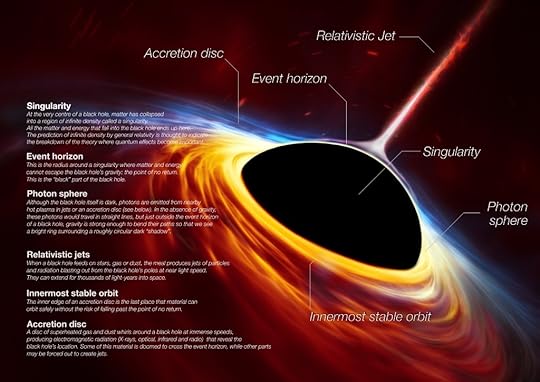
For all we know, advanced intelligence exists everywhere in the form of clouds of computronium or even photons encoded to host the minds of ancient beings. Or, as has been suggested by John Smart, a modern proponent of the Transcension Hypothesis, a highly-advanced species may choose to live around the event horizon of black holes, where they’ll enjoy access to endless energy, privacy, and maybe even the ability to see into other Universes!
While this sounds really speculative and way out there, that’s what we’re left with. When it comes to examples of life-bearing planets and technological civilizations, we have only one example to work with apiece (Earth and us!). Hence, we can do nothing but speculate about the evolution of life and advanced species since we have no other examples to go by. It’s therefore logical to take what we anticipate for ourselves and consider that someone, somewhere, has already achieved that (and then some!)
Interestingly, Stanley Kubrick and Arthur C. Clarke contemplated these questions at length while working on 2001: A Space Odyssey. According to the popular narrative, Kubrick wanted to do a scene with the alien intelligence that was the focal point of the story. According to a recent article by journalist Will Dowd at the Boston Globe, Kubrick originally wanted to with the classic lanky, humanoid grey skin design for his aliens, only taller:
“He dragged his visual effects team to a Giacometti exhibit at the Museum of Modern Art and pointed to the humanoid sculptures. He wanted his ETs to be just as thin and gangly, but 20 feet high. As the film ended, one of these spindly space creatures would reach down and take the astronaut Dave Bowman by the hand and together they would walk off into the sunset.”

In the end, Kubrick realized that an actual advanced alien species would be beyond anything we can imagine. This realization made Kubrick and Clarke decide to go with the Monolith, which was an example of the aliens’ technology! Each Monolith was composed of unknown black material in the shape of a flattened rectangle. While they differed in size, their proportions were exactly the same – 1:4:9, the square roots of 1, 2, and 3.
“Instead, his film would focus on humanity’s encounter with alien technology — those eerie black monoliths — rather than with the aliens themselves,” Dowd added. “It was a wise choice. The film remains as haunting today as when it premiered in 1968. And it’s more plausible. Scientists believe we’re far more likely to encounter a galaxy-traversing drone than, say, a species of galaxy-traversing space octopi.”
This very simple but intriguing design made the Monoliths awe-inspiring, imposing, and even terrifying. Looking at their black facade was like looking at an inscrutable face; worse, even, since there was no way of knowing if the things had a face. Their mysterious appearance only amplified the mystery surrounding their presence, capabilities, and ultimate intentions.
In the novelization, written by Clarke and released concurrently with the film, he gives the species a name: “The Firstborn.” As the name suggests, this species emerged in our galaxy long before humanity began exploring the stars to search for others like their kind. This inevitably led them to Earth, where they influenced the evolutionary development of early hominids. As Clarke describes it:
“In their exploration, they encountered life in many forms, and watched the workings of evolution on a thousand worlds. They saw how often the first faint sparks of intelligence flickered and died in the cosmic night,. And because, in all the galaxy, they had found nothing more precious than Mind, they encouraged its dawning everywhere. They became farmers in the fields of stars, they sowed, and sometimes, they reaped. And sometimes, dispassionately, they had to weed.”
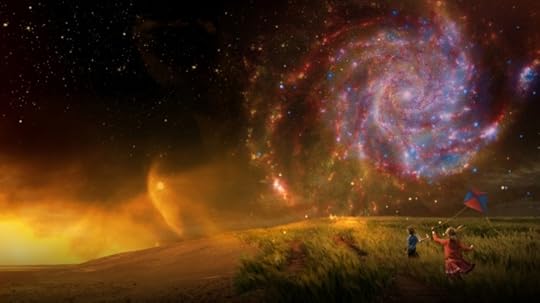
As for the monoliths themselves, Clarke added that this was part of the Firstborn’s own evolutionary development. What he wrote was consistent with what Tsiolkovsky and earlier cosmologists speculated about how life may one day achieve a state of Transcension and become a “perfect intelligence.”
“The first explorers of Earth had long since come to the limits of flesh and blood; as soon as their machines were better than their bodies, it was time to move. First their brains, and then their thoughts alone, they transferred into shining new homes of metal and of plastic. In these, they roamed among the stars. They no longer built spaceships. They were spaceships.”
It didn’t end there, but this was how the transcension process began, whereby the Firstborn merged themselves with their machines. The monoliths were the eventual result, which no longer carried the minds of these aliens, but remained as sentries on all of the worlds they had visited in the past. Like Innukshuks, they were a testament to the presence of the Firstborn.
However, it was J.M. Straczynski who introduced me to the concept of the “First Ones” in the first place. His SF series, Babylon 5 (1993-1998), remains one of the best I’ve ever seen and one that I’ve watched several times over. The story takes place about two hundred and fifty years in the future when humanity has just recovered from a rather disastrous war resulting from a first contact situation going wrong.
To ensure that such accidents didn’t happen again, Earth partnered with four other species – the Mimbari (the ones they had previously fought), the Centauri (a declining empire), the Narn (a rising empire and the ancestral enemy of the Centauri), and the Vorlons (a cryptic and ancient race). Long before the main story takes place, we learn that the First Ones dominated the galaxy – the first intelligent species to emerge in the Milky Way.
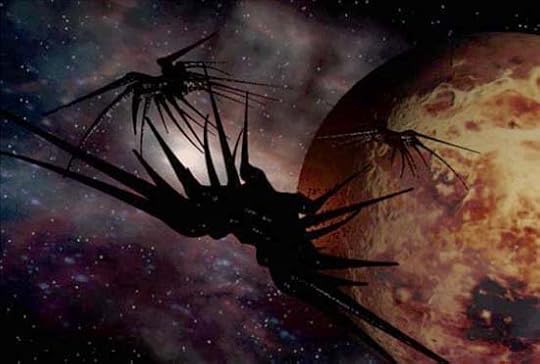
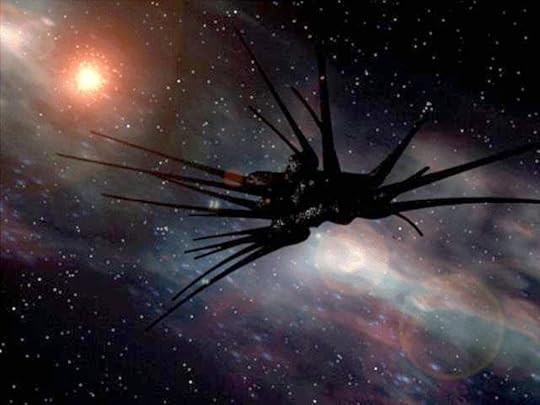

These races were shepherded by a single species that emerged before anyone else. Little is left of them in our galaxy as most passed beyond it to explore intergalactic space and other galaxies. Eventually, most First Ones followed suit, but some stayed behind to mentor new species that emerged in our galaxy. And as is so often the case, a war broke out to determine who would have ultimate control over these species’ evolution. One of the main characters in the story explains it as follows:
“There are beings in the Universe billions of years older than either of our races. Once, long ago, they walked amongst the stars like giants. Vast and timeless. They taught the younger races, explored beyond the rim, created great empires. But to all things, there is an end. Slowly, over a million years, the First Ones went away. Some passed beyond the stars, never to return. Some simply disappeared.
“Not all of the First Ones have gone away. A few stayed behind, hidden or asleep, waiting for the day when they may be needed… when the Shadows come again. We have no other name for them. The Shadows were old when even the ancients were young.”
The Shadows (shown above) are the oldest among the First Ones and believe that evolution is only achieved through chaos and struggle. In appearance, they look like insectoid beings with pitch-black skins that are almost liquid-like from the way they seem to flow. They can remain hidden by altering how their profile interacts with visible light, and their ships look like “something between a spider and your worst nightmare.”
In appearance, the Vorlons look like they might have a humanoid figure because of how their encounter suits are arranged (above left). Otherwise, they will take on the appearance of whatever species they visit, but with typical angel features (i.e., halos, inner light, wings, etc.). But without these pretenses, they look like energy-beings with squiddy-like profiles, and their ships (middle and right) look much the same since they are based on organic technology.
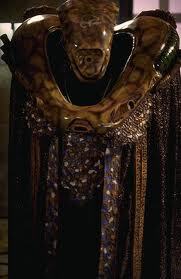
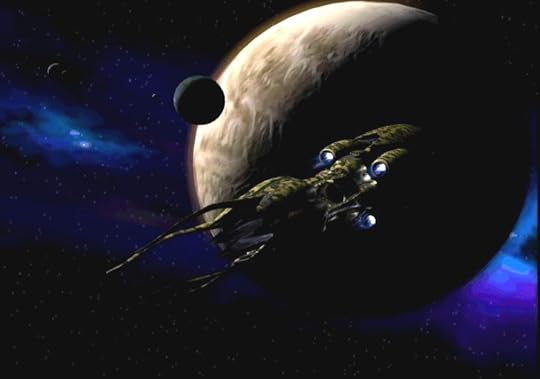

There was a balance of power for eons until one or both broke the truce and began fighting an ongoing war, largely through proxies. The Shadows recruited younger races to fight each other to further their ends, and they always approached would-be allies with the same question, “What do you want?”
The Vorlons manipulated younger species by appearing as beings of light, which less-advanced cultures saw as angels. They also genetically engineered species on many worlds to produce telepaths, which are vital to fighting the Shadows. The question they ask all those whom they approach is, “Who are you?”
Fun stuff? But what was especially brilliant was how J.M. Straczynski’s writing and the aesthetic he and his colleagues came up with captured the awe, mystery, and terror that an ancient species would arouse in less-advanced species (like us!). In the first season, one of the main characters tries to illustrate the dangers of encountering the First Ones by using an ant:
“I have just picked it up on the tip of my glove. If I put it down again, and it asks another ant, “what was that?”, how would it explain? There are things in the Universe billions of years older than either of our races. They’re vast, timeless, and if they’re aware of us at all, it is as little more than ants, and we have as much chance of communicating with them as an ant has with us. We know, we’ve tried, and we’ve learned that we can either stay out from underfoot or be stepped on.”
These words were clearly inspired by the master, Carl Sagan, who wrote and commented extensively on the subject of extraterrestrial intelligence and the search for them. In his 1983 essay, “The Solipsist Approach to Extraterrestrial Intelligence,” he summed it up pretty masterfully.
“We think it possible that the Milky Way is teeming with civilizations as far beyond our level of advance as we are beyond the ants, and paying about as much attention as we pay to the ants. Some subset of moderately advanced civilizations may be engaged in the exploration and colonization of other planetary systems; however, their mere existence makes it highly likely that their intentions are benign and that their sensitivities about societies at our level of technological adolescence delicate.”
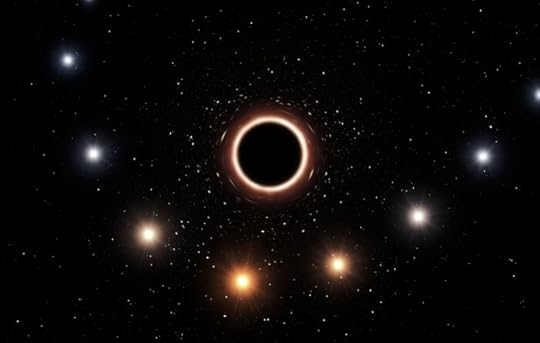
Years later, the contributions of these artists and scholars remain with me. When I began taking my first steps as an SF author, I knew that this was a subject that I wanted to tackle someday. Now that I’ve completed my first trilogy, I’m in a position to get into that. Since I haven’t started on it yet, I can’t get into specifics. But suffice it to say the mystery, awe, terror, and the unknown are all things I want to capture when I get around to writing about ancient extraterrestrial intelligence!
December 2, 2021
(Updated) Advice for Aspiring Writers!
Good morning! There’s something I’ve wanted to do for a long time now but never got around to it. And that is, share some tidbits of wisdom that I have learned over the years about writing. Most of these tidbits are things I learned from people who really knew what they were talking about, so I was sure to listen! Some others are just things I concluded along the way.
And wouldn’t you know it, the list has grown to include another important item since I originally scrawled them down. In any case, almost twenty years after I began writing, I’ve managed to condense the most important lessons I’ve learned down to six main tips. Here they are…
1. Do What You Love, the Money Will FollowSure, it sounds like an old cliche, but there’s a reason why cliches are cliches. They tend to be in a timeless sort of way, which is why we all get sick of hearing them. And when you hear this very bit of cliched wisdom from someone like J. Michael Straczynski (creator of Babylon 5 and Sense 8), you tend to take it seriously!
And it makes perfect sense. If your work is something you love doing, it doesn’t feel like work. This makes it so much easier to invest your time and energy into it and become good at what you’re doing. Given time, someone is sure to pay for you for doing it! And even if they don’t, you’re still doing what you love, so what does it really matter?
2. Keep Your Day JobThis advice is something I picked up from a fellow writer named Chris A. Jackson. And it made a ton of sense to me, so I kept it close at hand. It’s a wonderful thing to commit to a labor of love. But until such time that you can make enough money to support yourself, be sure you’ve got something else to pay the bills. It’s always good policy to have more than one iron in the fire.
3. Don’t Wait to be DiscoveredThis advice came to me from my boss and mentor in all things digital, publishing, and promotional: BC’s own Fraser Cain, famed science communicator and publisher of Universe Today. When we first met through his then-wife (a friend of mine who introduced us), he was intrigued that I was an aspiring science fiction writer. He took it upon himself to mentor me through the process of creation, submission, and self-promotion.
His advice, distilled to a few words, was “don’t wait to be discovered, put yourself out there.” This helped me overcome my biggest stumbling block, which is all-too-common for writers. Basically, once we’re done with the creative process, we have no idea how to proceed. Typically, we look to the traditional gatekeepers – the publishers, agents, promoters, etc. – and wait for them to notice us.
As per Fraser’s advice, I ditched that approach and began taking advantage of new media and independent publishing services to promote my work directly to the general public. I was able to build a following and a media presence. Ironically enough, this was how I gained the attention of a startup publishing house and got my books in print!
4. It Takes 20 Years to Become an Overnight SuccessMy father gave me this tidbit of advice almost twenty ago, and it stuck with me because it makes a ridiculous amount of sense. Like most things in life, things change slowly and only seem like they happened quickly in hindsight. You wake up one morning, and you realize how far you’ve come, and you ask yourself, “where did the time go?” It’s also an important reminder that no one hit it big right out of the gate. Take your time, work hard, be patient, and the kudos will eventually arrive!
5. Do Your HomeworkThis bit of advice comes directly from me and touches on another time-honored cliche: “Write what you know.” That’s good advice, in and of itself. While developing story ideas, you’re likely to stumble into subject matter that doesn’t fall into your area of expertise. Case in point: I once thought that the only limitations were my own imagination when it came to writing science fiction.
I know, I have a hard time believing I was ever that naive too! In time, I realized that if I wanted to write about SF and speculative fiction, I needed to read up on all the new developments in science, technology and the impact they would have socially, economically, politically, etc. It’s an ongoing process, and it’s never complete. So start early and never stop!
In addition to knowing your subject matter, you also need to know your genre. So before you set out writing that manuscript, be sure you’ve acquainted yourself with what has been said (and is being said) by other writers in your field. This will not only let you avoid doing something that’s been done to death, but it will also help you to refine what you are trying to say with your work.
6. TANSTAOHPO!“There Aint No Such Thing As One-Hundred Percent Original!” Here is another piece of advice that I learned the hard way. When you’ve got an idea, and you find yourself deep in the creative process, one of the worst things that can happen is for you to find out that somebody, somewhere, wrote something very similar. When that happens, it’s enough to make you wanna toss your manuscript in the trash (or recycle bin, let’s be responsible!).
But take it for me, this is entirely normal, and the best thing you can do is ignore that instinct and power through. For me, the moment came in 2015 when I was working on the manuscript for the Cronian Incident. The miniseries The Expanse premiered around the same time, and as I sat down to watch the first episode, I was hit with the terrible realization that’s someone had beaten me to the punch. This is what I like to call the “Oh Shit!” moment.
I was further discouraged when I cracked the cover of 2312 by Kim Stanley Robinson and noticed that he also beat me to the punch with a number of his story’s elements. Naturally, the thought of trashing my manuscript crossed my mind, but I persisted. Part of what kept me going was a story William Gibson related about how he nearly trashed the manuscript for Neuromancer, his seminal cyberpunk novel that revolutionized the genre, back in 1982.
As Gibson tells it, he was deep into writing Neuromancer when the film Blade Runner was released. After seeing the movie, he was so discouraged because he felt director Ridley Scott’s gritty depiction of Los Angeles in the 21st century predicted all of the elements of Gibson’s story. Lucky for us, Gibson persisted, and Neuromancer went on to become one of the most influential novels in the cyberpunk and SF genre.
The hard truth is that it’s damn-near impossible to be original, especially in today’s world. Even if you come up with an idea independently (chances are, you will), someone is likely to have thought it up already. But you can’t let that stop you. The same goes for rejection. If your manuscript has been rejected, don’t throw it out! Tweak it, polish it, work it, but don’t throw it out.
There will always be people who get there first and critics and readers who just don’t get what you’re putting down. But that’s the way it’s always been with the creative process. The truth is, there are countless versions of this story where authors almost quit but didn’t. If they had, some of the greatest works of literature would not exist today!
That’s what I’ve learned so far, and that’s what I want to pass on. I hope someone finds it useful! 



